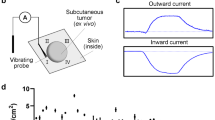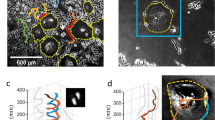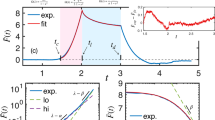Abstract
DIFFERENCES between the behaviour of normal fibroblasts and sarcoma cells have been observed in tissue culture by Abercrombie and Heaysman1. Normal fibroblasts affect each other's movements by contact inhibition, whereas sarcoma cells do not show inhibition either with respect to each other or to normal fibroblasts. Time-lapse colour films taken with the interference microscope (shown at the Bristol meeting (1955) of the British Association by E. J. Ambrose and M. Abercrombie) have shown that this difference in behaviour is due to differences in the mechanism of contact formation in the two cases, being dependent upon a loss of adhesiveness of the cell surface of the tumour cells. This reduction in the adhesiveness of the tumour cell suggests that the electrical properties of the surface may have altered during the malignant transformation. These properties may be investigated by electrophoretic measurements of cellular mobility. For example, studies of bacteria during growth, in the presence of bacteriostatic agents, have revealed marked changes in the nature of the cell surface, changes which are passed on to the progeny during subsequent growth, either in the presence or the absence of the drug. Thus the growth of Aerobacter aerogenes in the presence of proflavine2 or crystal violet3 gives rise to new populations of cells, which, although biologically indistinguishable from the original strain, have a distinctive electrometric behaviour.
This is a preview of subscription content, access via your institution
Access options
Subscribe to this journal
Receive 51 print issues and online access
$199.00 per year
only $3.90 per issue
Buy this article
- Purchase on Springer Link
- Instant access to full article PDF
Prices may be subject to local taxes which are calculated during checkout
Similar content being viewed by others
References
Abercrombie, M., and Heaysman, J. E. M., Exp. Cell Res., 5, 111 (1953); 6, 293 (1954); Nature, 174, 697 (1954).
James, A. M., and Barry, P. J., Biochim. Biophys. Acta, 15, 186 (1954).
Lowick, J. H. B., and James, A. M., Biochim. Biophys. Acta, 17, 424 (1955).
Abramson, H. A., Mayer, L. S., and Goner, H., “The Electrophoresis of Proteins”, 44 (Reinhold Pub. Co., 1942).
Anderson, N. G., Science, 117, 627 (1953).
Horning, E. S., and Whittick, J. W., Brit. J. Cancer, 8, 451 (1954).
de Long, R. P., Coman, D. R., and Zeidman, I., Cancer, 3, 718 (1950).
Author information
Authors and Affiliations
Rights and permissions
About this article
Cite this article
AMBROSE, E., JAMES, A. & LOWICK, J. Differences between the Electrical Charge carried by Normal and Homologous Tumour Cells. Nature 177, 576–577 (1956). https://doi.org/10.1038/177576a0
Issue Date:
DOI: https://doi.org/10.1038/177576a0
This article is cited by
Design and Investigation of the DM- PC-TFET-Based Biosensor for Breast Cancer Cell Detection
Transactions on Electrical and Electronic Materials (2023)
Why does thermomagnetic resonance affect cancer growth? A non-equilibrium thermophysical approach
Journal of Thermal Analysis and Calorimetry (2022)
Detection of cancer cells based on glycolytic-regulated surface electrical charges
Biophysics Reports (2019)
Microfluidics for cell separation
Medical & Biological Engineering & Computing (2010)
Role of Membrane Potential in the Regulation of Cell Proliferation and Differentiation
Stem Cell Reviews and Reports (2009)
Comments
By submitting a comment you agree to abide by our Terms and Community Guidelines. If you find something abusive or that does not comply with our terms or guidelines please flag it as inappropriate.



